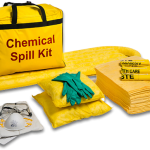Oil spills pose significant environmental and safety risks, requiring swift and effective response measures to contain and mitigate their impact. One essential tool for oil spill response is the oil spill kit bag, which contains the necessary equipment and supplies for rapid deployment and cleanup. In this blog post, we’ll explore the features and considerations to help you choose the right oil spill kit bag for your spill response needs.
Understanding the Importance of Oil Spill Kit Bags
Oil spill kit bags are specially designed containers that house absorbents, containment barriers, personal protective equipment (PPE), and other supplies essential for oil spill response and cleanup. These bags enable responders to quickly access the necessary tools and equipment during emergencies, facilitating a prompt and effective response to contain and mitigate oil spills.
Features to Consider When Choosing an Oil Spill Kit Bag
Size and Capacity: Consider the size and capacity of the oil spill kit bag based on the potential size and scope of spills in your facility or operation. Choose a bag that can accommodate sufficient absorbents and equipment to address spills of varying magnitudes.
Durability and Construction: Look for oil spill kit bags made from durable and water-resistant materials such as PVC, nylon, or polyurethane. Ensure that the bag is constructed with reinforced seams and sturdy handles for reliable performance in demanding environments.
Organization and Accessibility: Opt for a bag with multiple compartments, pockets, and organizers to keep contents neatly arranged and easily accessible during emergencies. Clear labelling and color-coded sections can further enhance organization and facilitate rapid deployment.
Portability and Mobility: Prioritize portability and ease of transport when selecting an oil spill kit bag. Choose a bag with ergonomic handles, padded shoulder straps, or wheels for convenient mobility, especially in large facilities or outdoor environments.
Customization Options: Look for oil spill kit bags that offer customization options to tailor the contents to your specific spill response needs. Some bags may allow you to add or remove components based on the types of spills commonly encountered in your facility.
Visibility and Identification: Select a bag with high-visibility colors or reflective strips to enhance visibility in low-light conditions or emergencies. Additionally, ensure that the bag is clearly labelled with identifying information such as the contents, emergency contact numbers, and usage instructions.
Considerations for Specialized Applications
If your operations involve specific types of oil or hazardous materials, consider specialized oil spill kit bags designed to address these requirements. For example, there are oil spill kit bags optimized for marine environments, offshore drilling operations, or industries handling corrosive chemicals.
Conclusion
Choosing the right oil spill kit bag is crucial for effective spill response and cleanup efforts. By considering factors such as size, durability, organization, portability, customization options, and specialized requirements, you can select a bag that meets the unique needs of your facility or operation. Investing in a high-quality oil spill kit bag ensures that your organization is well-prepared to respond to oil spills promptly, minimize environmental impact, and protect the safety of workers and communities.


